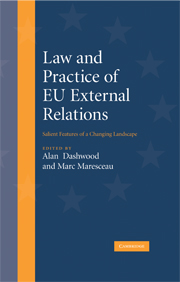Book contents
- Frontmatter
- Contents
- Abbreviations
- Notes on contributors
- Acknowledgements
- Introduction
- PART I Constitutional and institutional questions
- 1 Direct effect and interpretation of international agreements in the recent case law of the European Court of Justice
- 2 Defining competence in EU external relations: lessons from the Treaty reform process
- 3 Article 47 TEU and the relationship between first and second pillar competences
- 4 EC law and UN Security Council Resolutions – in search of the right fit
- 5 Fundamental rights and the interface between second and third pillar
- 6 The EU as a party to international agreements: shared competences, mixed responsibilities
- 7 The Common Commercial Policy enhanced by the Reform Treaty of Lisbon?
- 8 The extent to which the EC legislature takes account of WTO obligations: jousting lessons from the European Parliament
- PART II Bilateral and regional approaches
- PART III Selected substantive areas
- Table of Treaty Provisions
- Index
4 - EC law and UN Security Council Resolutions – in search of the right fit
from PART I - Constitutional and institutional questions
Published online by Cambridge University Press: 07 September 2009
- Frontmatter
- Contents
- Abbreviations
- Notes on contributors
- Acknowledgements
- Introduction
- PART I Constitutional and institutional questions
- 1 Direct effect and interpretation of international agreements in the recent case law of the European Court of Justice
- 2 Defining competence in EU external relations: lessons from the Treaty reform process
- 3 Article 47 TEU and the relationship between first and second pillar competences
- 4 EC law and UN Security Council Resolutions – in search of the right fit
- 5 Fundamental rights and the interface between second and third pillar
- 6 The EU as a party to international agreements: shared competences, mixed responsibilities
- 7 The Common Commercial Policy enhanced by the Reform Treaty of Lisbon?
- 8 The extent to which the EC legislature takes account of WTO obligations: jousting lessons from the European Parliament
- PART II Bilateral and regional approaches
- PART III Selected substantive areas
- Table of Treaty Provisions
- Index
Summary
Introduction
The European Union (EU) has long been a busy international actor. Early on in the development of EC law, the European Court of Justice (ECJ) confirmed that the European Economic Community (EEC) could conclude ‘international agreements in most if not all its spheres of activity’. The EEC, later European Community (EC), has made very active use of that international legal capacity. As its activities are ever expanding, the number and scope of the international agreements which the EC concludes increases as well. With the conclusion of international agreements have come questions about the legal effects which such agreements produce. The ECJ had to develop its own doctrine on the matter, and this doctrine cannot be neatly encapsulated in a single concept. It is true that scholars, and at times the ECJ itself, have used the ‘direct effect’ catchphrase: most international agreements have such direct effect, but some international agreements do not. A more detailed analysis of the relevant law shows, however, that this catchphrase is no more than just that, and may sometimes even be deceptive.
It is not the object of this paper to return to the legal effects which international agreements, as such, produce. The international legal landscape is fast evolving. International treaties are no longer just about relations between international actors. They often include an institutional framework or set up a full-blown organisation. The founding treaties then become living instruments, on the basis of which myriad different decisions are adopted.
- Type
- Chapter
- Information
- Law and Practice of EU External RelationsSalient Features of a Changing Landscape, pp. 104 - 128Publisher: Cambridge University PressPrint publication year: 2008
- 2
- Cited by

